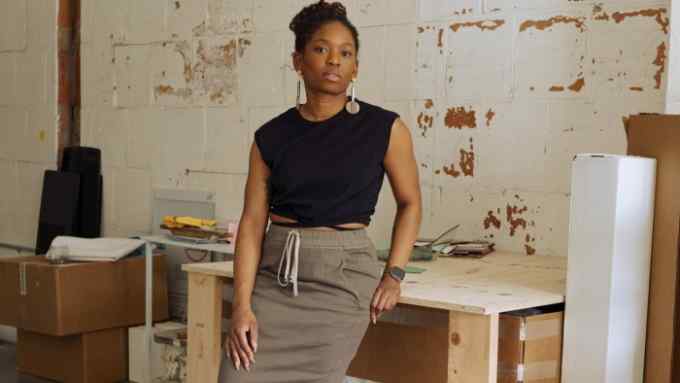Gallerist Ales Ortuzar: ‘I wanted to break the echo chamber’

Roula Khalaf, Editor of the FT, selects her favourite stories in this weekly newsletter.
As artists represented by Ortuzar Projects crop up in major biennials and make auction records, one might imagine that the gallery has a long history and an even longer artist roster. Yet Ortuzar Projects, which was founded as a two-year project space, is a mere six years old and intends to keep its roster, if not its recently tripled Tribeca footprint, trim.
The gallery’s artist list comprises 14 20th- and 21st-century artists who founder Ales Ortuzar feels have been overlooked in New York. Two, Suzanne Jackson and Takako Yamaguchi, feature in this year’s Whitney Biennial; a painting by Ernie Barnes soared past its high estimate of $200,000 to sell for $15.3mn in 2022. With his tight roster, Ortuzar can work closely with artists on exhibitions, publications, acquisitions and the creation of foundations.
Spanish-born Ortuzar, who says he is wary of “growth for growth’s sake”, cut his teeth at mega-gallery David Zwirner; after joining in 2008, he climbed the ranks to partner during its global expansion. “It had become such a big gallery, staging so many exhibitions at once and participating in so many art fairs,” he says. When he departed to open an independent art advisory business in 2015, he began to imagine a more intimately scaled gallery of his own.

“Having lived in Spain and England prior to moving to New York, I got the sense that people in a particular city or country are all looking at the same artists,” he says. “I wanted to break the echo chamber and create a meaningful platform for artists that hadn’t had proper exposure here, even if they were well-known elsewhere.”
Ortuzar Projects is certainly not alone in highlighting important artists whom history has neglected — indeed, the framing of artists as “overlooked” or “rediscovered” is something of a trope — though the gallery’s emphasis on artists who are underacknowledged in the US but celebrated elsewhere is a bit more specific. For its inaugural exhibition, Ortuzar Projects held the first US solo show of abstract painter Michel Parmentier, a member of the Paris-based BMPT artist collective in the 1960s, pairing the artist’s striped canvases and works on paper with archival material. His work has for decades been exhibited in his native France.

“That exhibition was, to my mind, the least fashionable thing [Ortuzar] could’ve done,” says New York painter Matt Connors, who will have a solo presentation with the gallery this summer. “Parmentier is among my favourite artists, and the show was so well-researched and beautiful. It was a shot heard around my friend group.”
Other firsts followed. Ortuzar Projects presented Lisa Ponti and Claudette Johnson’s first US solo shows and gave Jackson and Key Hiraga their New York solo debuts. The gallery also mounted shows that broke long dormant stretches in artists’ New York exhibition histories. When it held a mini-survey of paintings by Maruja Mallo in 2018, the Spanish artist hadn’t had a solo turn around New York since 1948; an exhibition of paintings, drawings, collages and zines by American artist Joey Terrill in 2021 marked his first in the city in four decades. Mallo and Terrill went on to feature in the 2022 Venice Biennale and the Hammer Museum’s biennial Made in LA 2023, respectively.

The gallery’s clients, says Ortuzar, are predominantly established collectors, with a focus on institutions. “We have been seeing a significant re-evaluation of the art-historical canon over the past decade in particular, with museums and collectors alike recognising how many significant, vital artists have gone underrecognised and undercollected,” he says.
One such artist is Paraguayan-born Feliciano Centurión, who is the subject of Ortuzar Projects’ booth at Frieze New York. Centurión, who died from Aids-related complications at the age of 34 in 1996, made subversive textile-based works that were kitschy, tender and, following his diagnosis, diaristic. His practice has gained attention in recent years, with a milestone inclusion in the 2018 São Paulo Biennial and a debut US solo show at the Americas Society in New York in 2020.

The works in the booth range from $75,000 to $250,000 and include a selection of the artist’s frazadas — humble blankets that he painted, collaged and embroidered with depictions of plants and animals and inscriptions such as “Soy el flujo del tiempo que no se detiene” (“I am the flow of time that does not stop”). “I’ve been working toward this moment for years,” says Ortuzar. The gallery will mount an exhibition devoted to the artist later this year.
For Ortuzar, the belief that the gallery “can have a real impact on a particular artist’s career” is central to decision-making around representation. Take Jackson, a Savannah-based artist who makes sculptural acrylic paintings without canvas. After her 2019 show — which sold out — Ortuzar Projects mounted a group exhibition revisiting The Sapphire Show, a historically important presentation of work by Black women artists, including Betye Saar and Senga Nengudi, that Jackson held at her Los Angeles project space Gallery 32 for one weekend in the summer of 1970.
“I’m exclusively with Ortuzar and I will be with them until they or I leave the Earth,” Jackson says. The gallery has helped to place her work in major museum collections including MoMA, the Whitney, the Walker Art Center in Minneapolis and the San Francisco Museum of Modern Art, where she will have a solo exhibition in 2025. “We live in an imperfect world where artists like Suzanne [Jackson] can go unnoticed for a decade,” says Ortuzar. “It’s gratifying to see that change.”

Comments